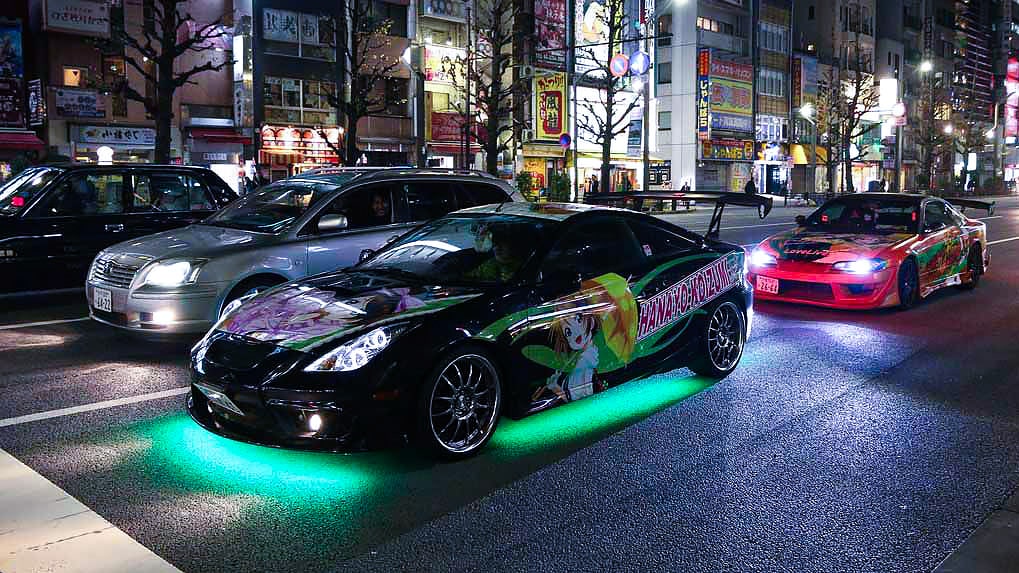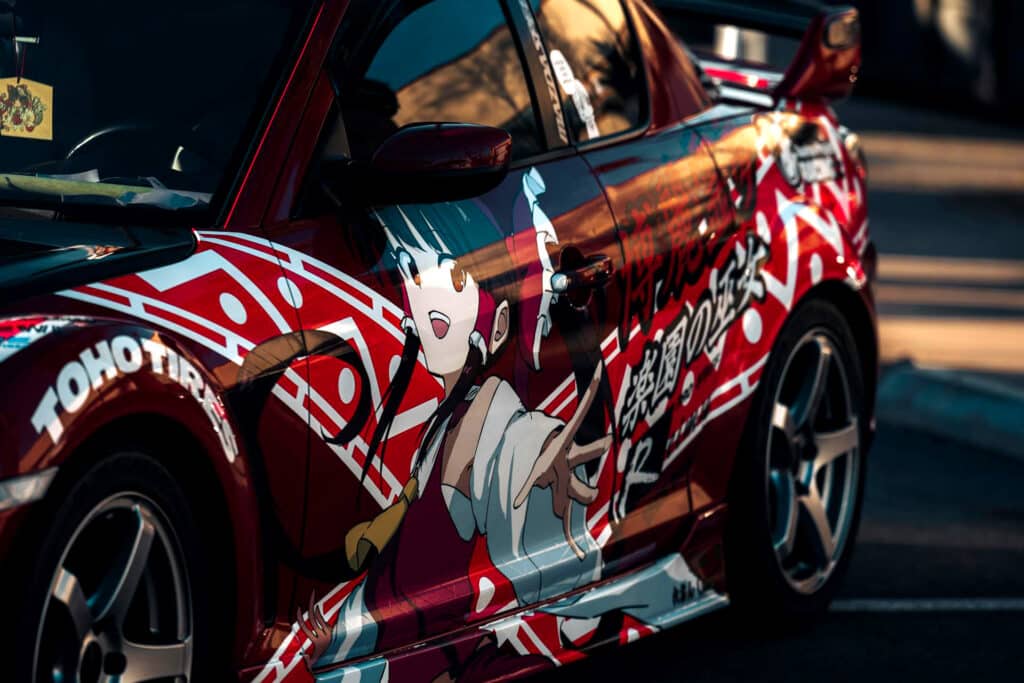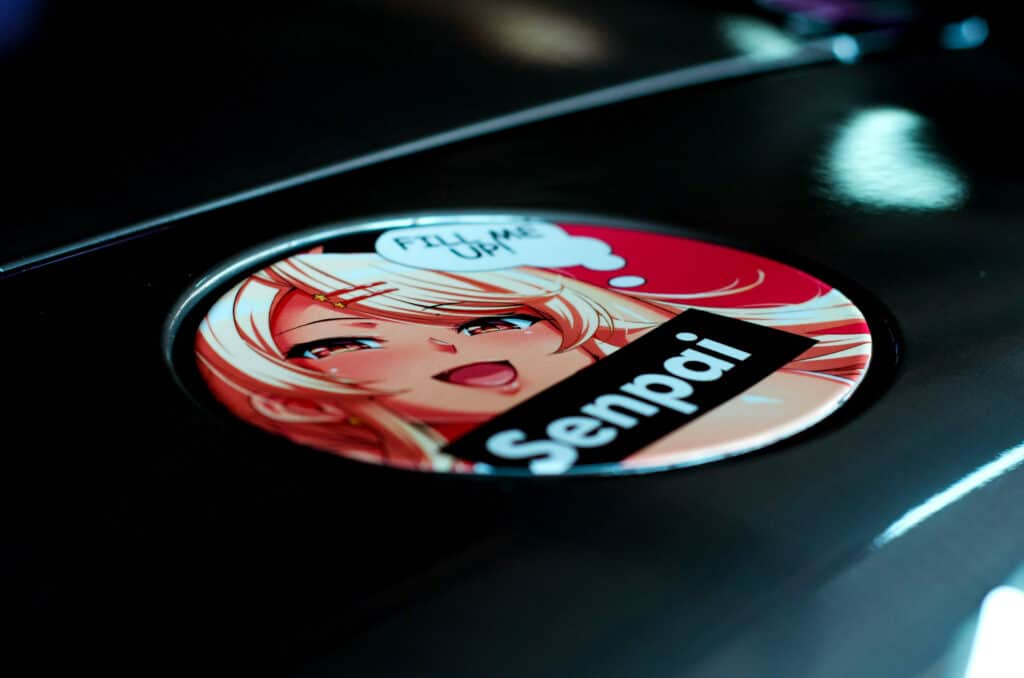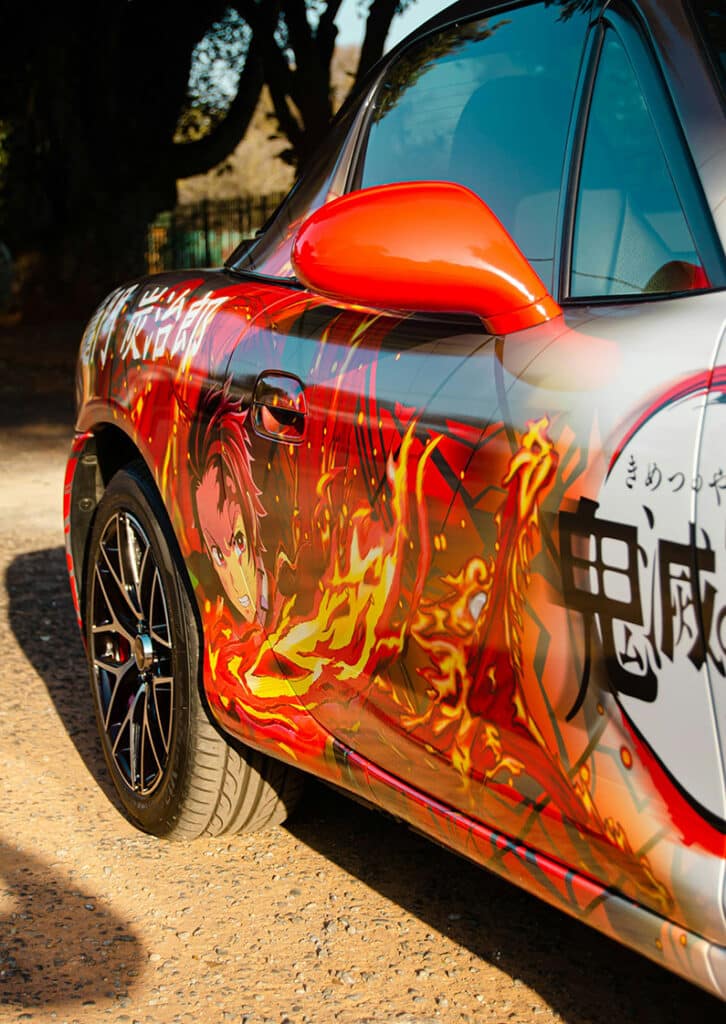Other than better handling and performance, self-expression is one of the main reasons so many car enthusiasts choose to modify their vehicles.
We’ve seen dozens of cars that let their owner’s personality and interests shine through, whether that’s comic books, aviation, or simply inspiration from early-2000s car culture.
There are many established styles for modifying cars, but one such aesthetic or sub-culture that’s been sparking interest in recent years is called itasha.
In this guide, we’ll go over everything there is to know about itasha culture, including its origins, the huge amount of hate surrounding them, and whether you should do up your car in this style.
Itashas and Anime Cars: An Overview
Itasha comes from fusing the Japanese words for “painful” or “cringeworthy” and “car” together.
A more accurate translation would be a car that is an eyesore, or is not worth looking at. The term itasha generally applies to the car’s decal work, which always involves some type of anime character.

Anime is popular all over the world; itasha cars can feature anime characters from just about every genre, but a familiar theme is characters from eroge or so-called bishojo games.
Eroge, as the term may allude to, refers to erotic video games, whereas bishojo video games revolve around interactions with attractive women.
This explains why so many cars labelled as itasha almost always feature a female character in the decal work, but that doesn’t have to be the case.
There are a few rare cases of other characters from more well-known anime that don’t involve the above-mentioned categories, however, most itasha cars generally revolve around the same themes.
A prominent character featured on anime-themed cars is Hatsune Miku, the vocaloid idol that has a loyal following all over the world, but tons of other female characters can be seen commonly.
The Origins of Itasha: Economic Bubbles and Geek Culture

The term itasha originally didn’t mean what it does today.
During Japan’s economic bubble, dozens of imported cars from Europe came into the land, and a lot of the Italian ones received the nickname “itasha,” which in this context literally translates to “Italian car,” as shortened from “Itaria-sha.”
It started out slower in Japan, but eventually gained a pretty loyal following on a global scale due to anime’s increased popularity, spawning the creation of itasha-themed cars. Moreover, itasha cars are an extension of the massive otaku/geek culture in Japan.
Today, it’s very difficult to go to a car meet of any kind in Japan without encountering at least one anime-themed car, and we don’t mean real-life recreations of the Fujiwara Tofu Shop Toyota AE86 or the Devil Z.
Why Are They So Popular?
As mentioned previously, itashas and anime-themed cars have experienced a massive surge in popularity, not just in Japan, but all over the world.
During the time when itasha originated, mangas, anime, and video games began to take the world by storm, which naturally led to merchandise.
Action figures and merchandise are the key pillars of otaku culture, so it’s only natural that people would want to apply an itasha livery to their car.
The first actual itasha car appeared in 2005 at the Japanese comic convention, Comiket. Sadly, this car is lost to time.

In 2007, Autosalone, the first ever itasha-themed car show was held. Ever since then, itasha cars have exploded in popularity, and it’s one of the most common ways of customizing a car in Japan, and it’s getting even more common today.
Itasha cars are also meant to celebrate strong female characters in anime, and the owners of these cars use them to express their love for said characters.
If you’ve been around anime in any capacity, you’ve probably heard the term “waifu.” That’s pretty much one of the main reasons you see female anime characters on these cars.
It’s quite simple: itasha cars are popular because anime and manga is popular.
We all know that anime and manga have some of the most dedicated fanbases in the world, so it’s only natural that car enthusiasts that also have an interest in anime will make their cars reflect that interest openly.
The Hate Towards Anime Cars
One thing that’s commonplace in itasha culture, from the outside-in, is the negative comments. Itasha cars get a bad rap for a reason—there’s a pretty large subset of the car community that really doesn’t like them.
The same is true for other subcultures like Onikyan and Bosozoku. Back in the early days, itashas were seen as rebellious and wrong by automotive purists, who argued that these brave liveries destroy the car.

There are a few reasons why this happens. The most common one, as you might expect, is the negative stereotype and image that shrouds fans of anime. In this subset of negativity, anime fans and fans of Japanese culture are known as weeaboos or weebs.
For years and years, we’ve heard all sorts of stories about weebs and weeb culture, and itasha cars have weeb culture written all over them, so it’s easy to see where part of that negativity stems from.
Another major reason why anime-themed cars get a lot of hate is simply because they’re different. This is a common trait for just about every community out there, even beyond the world of cars.
If something different or daring comes along, there will always be a very vocal crowd who hates it.
As we all know, the car community doesn’t always respond well whenever there’s a new car coming out, and they also don’t take too well with certain engine swaps, or custom builds that dare to stand out and be different.
Itasha cars are all about being different and out there, so they will always attract negative comments from some facets of the community.
There’s also the moral side to this coin. Let’s not forget that some of the so-called waifus, i.e attractive women from anime are actually not of age, and yet are depicted wearing revealing garments and posing inappropriately, which is rightfully seen as objectifying and fetishizing the characters.

This is not always the case, but you can see why this would cause some people to question itasha cars.
Should You Put an Itasha Wrap On Your Car?
If you’re a fan of anime and certain characters in anime, and if you want your car to reflect your personality, wherein anime is also a major part of your personality, then the answer is absolutely yes.
Setting aside the questionable depictions of characters on some itasha cars, their main purpose is to celebrate those characters, and to stand out and show the enthusiasts’ love for anime. If this sounds anything like you, then you should give itasha wraps a try.
Just keep in mind, they are a little more out there, but as long as they are within social realms, and you’re ready to get hated on by a lot of enthusiasts in and out of your circle.
Then again, the automotive community is full of people who explain how cars should and shouldn’t look, and if you’re a fan of a particular aesthetic, and if it fits with the theme of your build, don’t bother yourself with that.
Concluding Summary

Itashas are gaining some traction among car enthusiasts all over the world, having enjoyed a cult following in Japan.
The history behind them is quite interesting, with their roots in geek culture, anime and merchandise, and especially the fact that it took a while before otaku culture reached cars.
Today, itasha cars have a loyal following, and a loyal group of haters as well. While their intentions are to celebrate the characters and for the owners to show the world their love for anime culture, they’re often misrepresented and morally incorrect.
The beauty of modified cars is that they can be a true expression of the owner’s personality.
There’s always going to be a group of people who dislike something brave and unusual, but if you’re a fan of anime and you want to celebrate a strong female lead through your car, an anime-themed wrap is definitely worth considering.
What’s your take on this sub-culture? Let us know by leaving a comment below!

